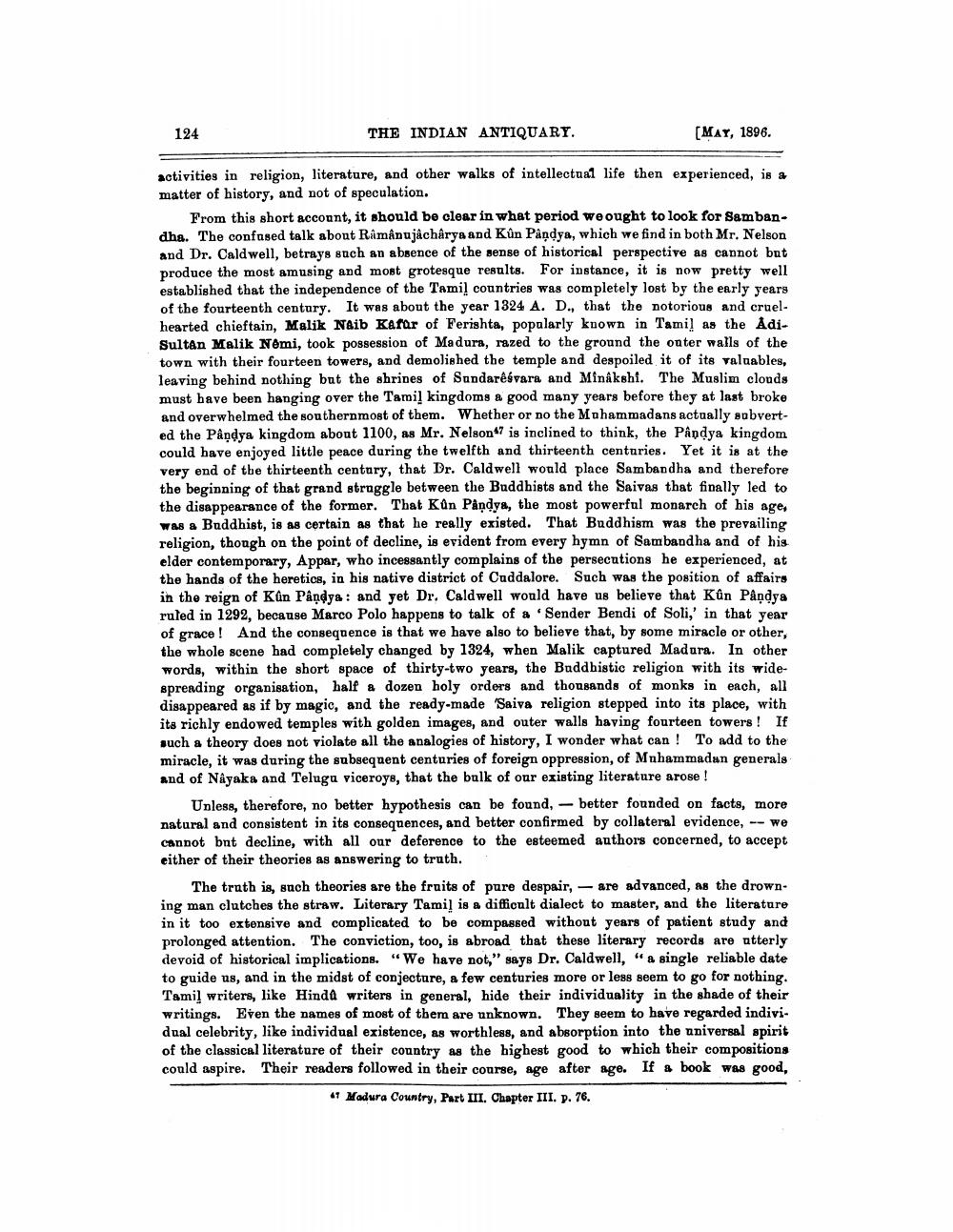________________
124
THE INDIAN ANTIQUARY.
(MAY, 1896.
activities in religion, literature, and other walks of intellectual life then experienced, is a matter of history, and not of speculation.
From this short account, it should be clear in what period we ought to look for Sambandha. The confused talk about Ramanujâcharya and Kûn Pandya, which we find in both Mr. Nelson and Dr. Caldwell, betrays such an absence of the sense of historical perspective as cannot but produce the most amusing and most grotesque results. For instance, it is now pretty well established that the independence of the Tamil countries was completely lost by the early years of the fourteenth century. It was about the year 1324 A. D. that the notorious and cruelhearted chieftain, Malik Naib Kafur of Ferishta, popularly known in Tamil as the AdiSultan Malik Nomi, took possession of Madura, razed to the ground the outer walls of the town with their fourteen towers, and demolished the temple and despoiled it of its valuables, leaving behind nothing but the shrines of Sundarêśvara and Minakshi. The Muslim clouds must bave been hanging over the Tamil kingdoms a good many years before they at last broke and overwhelmed the southernmost of them. Whether or no the Muhammadans actually subverted the Pandya kingdom about 1100, as Mr. Nelson 67 is inclined to think, the Pandya kingdom could have enjoyed little peace during the twelfth and thirteenth centuries. Yet it is at the very end of the thirteenth century, that Dr. Caldwell would place Sambandha and therefore the beginning of that grand struggle between the Buddhists and the Saivas that finally led to the disappearance of the former. That Kun Påndys, the most powerful monarch of his age, was a Buddhist, is as certain as that he really existed. That Buddhism was the prevailing religion, though on the point of decline, is evident from every hymn of Sambandha and of his elder contemporary, Appar, who incessantly complains of the persecutions he experienced, at the hands of the heretics, in his native district of Cuddalore. Such was the position of affairs in the reign of Kun Pandya : and yet Dr. Caldwell would have us believe that Kûn Påndya ruled in 1292, because Marco Polo happens to talk of a Sender Bendi of Soli,' in that year of grace! And the consequence is that we have also to believe that, by some miracle or other, the whole scene had completely changed by 1324, when Malik captured Madura. In other words, within the short space of thirty-two years, the Buddhistic religion with its widespreading organisation, half a dozen holy orders and thousands of monks in each, all disappeared as if by magic, and the ready-made Saiva religion stepped into its place, with its richly endowed temples with golden images, and outer walls having fourteen towers! If such a theory does not violate all the analogies of history, I wonder what can ! To add to the miracle, it was during the subsequent centuries of foreign oppression, of Muhammadan generals and of Nayaka and Telugu viceroys, that the bulk of our existing literature arose !
Unless, therefore, no better hypothesis can be found, - better founded on facts, more natural and consistent in its consequences, and better confirmed by collateral evidence, -- we cannot bnt decline, with all our deference to the esteemed authors concerned, to accept either of their theories as answering to truth.
The truth is, such theories are the fruits of pare despair, - are advanced, as the drown. ing man clutches the straw. Literary Tamil is a difficult dialect to master, and the literature in it too extensive and complicated to be compassed without years of patient study and prolonged attention. The conviction, too, is abroad that these literary records are atterly devoid of historical implications. “We have not," says Dr. Caldwell," a single reliable date to guide us, and in the midst of conjecture, a few centuries more or less seem to go for nothing. Tamil writers, like Hindd writers in general, hide their individuality in the shade of their writings. Even the names of most of them are unknown. They seem to have regarded individual celebrity, like individual existence, as worthless, and absorption into the universal spirit of the classical literature of their country as the highest good to which their compositions could aspire. Their readers followed in their course, age after age. If a book was good,
41 Madura Country, Part III. Chapter III. p. 76.




